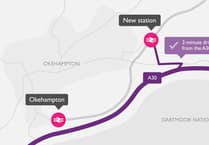The number of car charging points in South Hams could be set to increase as part of a wider strategy on electric vehicles, the district council has said.
South Hams District Council (SHDC) recently laid out a two-year plan on how to improve vehicle charging for both residents and visitors in a bid to encourage wider use of electric vehicles, particularly in more remote areas.
In a 24-page report, SHDC warned that South Hams faced “very specific challenges”, warning that there was a risk that more rural locations could be left behind in the move to fully transition to EVs.
The problem was compounded by the fact that South Hams has a “geographically sparse population which makes it unsafe to walk and cycle”, as well as a relatively poor public transport infrastructure.
The UK government last year revised its targets to phase out new petrol and diesel cars, delaying a full ban until 2035. However, 80 per cent of new cars and 70 per cent of new vans sold in Britain will still be required to be zero emission by 2030.
According to SHDC, there are currently almost 900 battery electric vehicles (BEV) registered in South Hams, up from just over 100 at the end of 2018. By 2025, that number is expected to soar to more than 5,300, representing a 7.65 per cent increase.
There are currently electric vehicle charging (EVC) bays in Ivybridge, Kingsbridge, Dartmouth (which are among the most widely used), Totnes, Salcombe and Modbury.
However, to meet the growing demand for EVs, there are also plans to install EV chargers in the Steamer Quay and North Street car parks in Totnes, as well as in the Duncome Park and Lower Union Road car parks in Kingsbridge.
EV chargers are classed as ‘rapid’, ‘ultra-rapid’, ‘fast’ and ‘slow’, depending on their speed. Rapid chargers (rated at 50kW, and normally located by roadside and motorway service stations) will typically refill an EV battery to 80 per cent in about 40 minutes.
But due to the distances involved between towns in South Hams, range anxiety is still a major issue for drivers who are considering switching from a traditional internal combustion engine (ICE) to an EV.
As a result, EV chargers in South Hams will require grid upgrades “in most circumstances”. And as the type of charger installed is dependent on grid capacity, installing banks of fast and rapid chargers in more remote areas will also prove a greater challenge.
Local councils across South Hams have been showing greater interest in EV use. Kingsbridge council recently conducted a feasibility study involving SHDC and Devon County Council (DCC) on whether to introduce an electric vehicle hire scheme in the town, while Salcombe council welcomed plans by a private firm to start a net zero electric bus shuttle service in the resort.
Charging at home usually happens off-street in garages and driveways, but this is not possible for many people.
Despite facing huge financial constraints which could impact on councils’ ambitious net-zero plans, there is an on-street residential chargepoint scheme (ORCS) which provides grant funding for local authorities to install residential chargepoints.
In Devon, DCC funds 60 per cent of the costs of procuring and installing a residential chargepoint and dedicated parking bay.
John McKay, South Hams District Council’s executive member for climate change and biodiversity, said budget constraints would not affect the roll out of Local EV Infrastructure (LEVI).
“Our ability to roll out EV Charging is independent of our core budget. LEVI funding is established by the government and DCC are the responsible authority for managing Devon’s allocation,” he said.
“Any charging we do in house will depend on a business case and in instances where we fully own and operate we are able to recoup costs through charging fees. So far we’ve been looking at seven and 22kw chargers as they are cheaper and don’t rely on grid reinforcement.”
According to Zapmap, which provides a UK-wide map of electric car charging points, there are just over 53,000 EVCs across the country, across 30,853 charging locations, representing a 46 per cent increase since November 2022.



